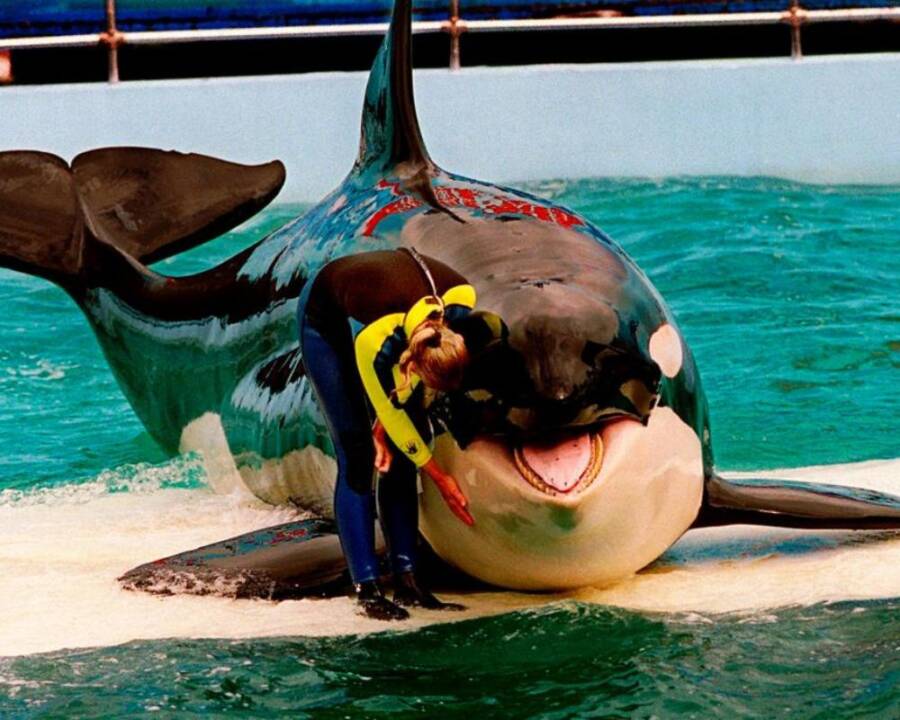The Miami Seaquarium announced that 57-year-old Lolita, also known as Tokitae, will be relocated to the waters of the Pacific Northwest, where trainers hope she will one day reunite with her family.

Wikimedia CommonsLolita the orca performing at the Miami Seaquarium in 1998.
A 57-year-old female orca known as Lolita, or Tokitae, is moving from her tank at the Miami Seaquarium to her home waters in the Pacific Northwest, where trainers will teach her the skills needed to hopefully be successfully reintroduced into the wild.
Orcas like Lolita were first used in the entertainment industry in the 1960s after an aquarium owner captured one off the coast of British Columbia. The creature became a sensation, and soon, aquariums all over the country were scrambling to get one of their own.
In 1970, fishermen trapped Lolita and at least 79 other orcas near Whidbey Island, Washington. After her capture, she began performing at the Miami Seaquarium in the smallest orca pool in North America. It measured just 80 feet long and 35 feet wide — about the size of a tennis court. For 50 years, Lolita lived and worked there, becoming a beloved feature of the aquarium.
Just last month, the aquarium and Friends of Lolita, a conservation group that has been campaigning for Lolita’s release, announced plans to relocate the orca back to her home waters. Lolita retired from performing at the aquarium in March 2022, and conservation groups hoped she could live out the rest of her days in peace back where she belongs.
“We owe them a retirement program, a pension… giving them back something like this is the least we can do,” Charles Vinick, a member of the Whale Sanctuary Project that helps free captive whales around the world, told The Guardian.
Because of Lolita’s age and the time she’s spent in captivity, her caretakers will not immediately release her into the wild. For now, organizations have made plans to keep her in a 15-acre netted sea pen and provide around-the-clock care and training to hopefully prepare her for eventual release.
“Lolita will receive the highest quality care as the team works to make relocation possible in the next 18 to 24 months,” Miami Seaquarium said in a statement Thursday, as reported by CNN.
Lolita’s move will not be an easy one. Transporters will use cranes to lift her, fly her across the country in a water tank, and then load her onto a barge. The total cost may reach eight figures.
“I know Lolita wants to get to free waters,” said Jim Irsay, the Indianapolis Colts owner who is helping to finance the orca’s move. “I don’t care what anyone says. She’s lived this long to have this opportunity. And my only mission is… to help this whale get free.”
Regardless of the cost, conservationists are ecstatic that Lolita has a shot at freedom. What’s more, Lolita may even be able to reunite with her family.

Twitter/New York PostLolita has been at the Miami Seaquarium since 1970, when she was just four years old. She is now 57.
Experts believe that Lolita’s 90-year-old mother may still live in the Salish Sea area. They have identified a whale who is the matriarch of the L-pod, one of three orca clans that make up the population of southern resident killer whales. This genetically unique group is often spotted between Washington and British Columbia.
Given that Lolita had lived and hunted with her pod for four years before she was captured, her caretakers believe that she may still remember her family.
In 1996, researchers recorded the calls of Lolita’s family members and played the sounds to the orca in Miami. She immediately appeared to recognize the calls and began bobbing and playing in the water. Experts are still unsure if Lolita could communicate with her family, but they hope that the orcas will accept her into the pod if she ever makes contact.
“The first objective is to provide her the highest quality of life we can,” Vinick said, per the Associated Press. “Whether or not it becomes the dream of having her reunite with L-pod is something we have to rely on Lolita to show us.”
Many long-time advocates for Lolita’s release are hopeful that she will make an eventual transition back into the wild, but it certainly will not come without challenges.
The only long-term captive orca humans have ever released into the wild was Keiko, the orca who starred in the movie Free Willy.
In 2002, tremendous efforts from people around the world led to Keiko’s release in Icelandic waters. Only a year later, he died of pneumonia, sparking fears that captive orcas could never successfully be released back into the wild.
However, footage showing once-captive orcas hunting and playing within wild orca pods provides some hope that integration is still possible.
The world is now rooting for Lolita’s return home. As Howard Garrett, the president of the board of the advocacy group Orca Network, said, “This is a step toward righting a great wrong that humans have done.”
After reading about Lolita the orca, discover drone footage that dives into the complicated social lives of killer whales. Then, learn the story of Dawn Brancheau, the trainer who was killed by the orca Tilikum at SeaWorld in 2010.





